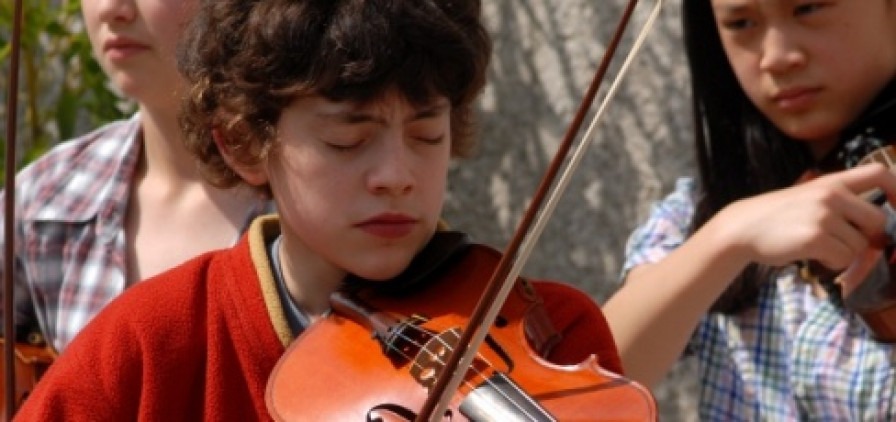About South West Music School

Lisa Tregale reflects on the work and educational model of South West Music School
South West Music School (SWMS) is part of a national network of Centres for Advanced Training (CATs) supported by the Department for Education Music and Dance Scheme for exceptionally talented young musicians aged between eight and 18.
This page is part of a resource collection: How South West Music School supports musical ability.
History
Originally founded in 2007 as a partnership between the Bournemouth Symphony Orchestra, Dartington Hall Trust, Federation of Music Services South West, Wells Cathedral School, and Wiltshire Music Centre, SWMS became an independent company limited by guarantee and registered charity in 2010.
The model
CEO & Artistic Director Lisa Tregale describes the SWMS ‘virtual’ model – ‘a junior conservatoire with no building base’ – offering support to young musicians through mentoring, specialist tuition and residentials.
Lisa notes that this model fits the region well, as it ‘works as close to home as possible’, enabling access by talented young people – often from lower income families and rurally isolated – to individualised expert support.
Promotion
SWMS promotes its programme to young people across the region through press campaigns, e newsletters to local authority music services, heads of music in schools, youth services and music organisations, and through Facebook, Twitter and general ‘word of mouth’. Numbers of students have grown from 15 in the first year to a current maximum of 45 on the core programme and 30 on the feeder scheme, which was introduced in 2009. A composers’ strand was added in autumn 2011.
Applying and auditioning
Here Lisa describes how talented young people can get involved in SWMS, explaining the two stage application process. Prospective students submit an application form with a reference and a recording and those selected then attend a whole day audition, which includes playing to a panel as well as taking part in a group creative music workshop and talking with one of the mentor team.
Model elements
The feeder scheme comprises six workshops spread across the year covering topics such as improvisation, performance practice, listening, rhythm and performance health. Students also receive advice on what other music opportunities are available, contacts for teachers and support for practice.
Here Lisa describes in more detail the tuition, mentoring and residential elements of the core programme and how they work together. Great importance is placed on getting the ‘mentor match’ right and specialist teaching – through individual tutoring, masterclasses and intensive weekends – is all about providing bespoke, high quality support. Residentials develop students’ general musicianship. They work with each other across age ranges, instruments and genres, getting involved in a wide variety of playing from the Baroque to the contemporary and from folk to improvisation. The SWMS model ‘places the young person in the middle’, encourages them in self reflection and the development of mutual respect with others.
What works well
Lisa talks more about the bespoke and flexible nature of SWMS provision which places young people at its heart and is responsive to changes in the music industry, enabling students to be ‘fit for’ a varied world of music work. Dialogue with the student and their parents informs their progression.
How to work well
Here Lisa focuses on how developing networks and partnerships, along with listening to young people, celebrating their achievements and recognising the scope of their musical interests, has informed her approach to developing SWMS’s work in what is such a large region.
Reflective practice
Rigorous documentation and regular evaluation contribute to learning and development, for both students and staff, as Lisa explains. Auditions are recorded; Individual Learning Plans formally reviewed every year; mentor and tutor reports written; students engage in self evaluation; and their feedback about SWMS is taken on board.
Issues
While the SWMS model works well, Lisa acknowledges there are also challenges. These include not being able to see her mentoring and tutoring staff on a regular basis, making for lots of ‘phone calls and a successful reliance on their professionalism. Staff and students alike are encouraged to raise any issues and generally feel ‘part of the SWMS family’, even if it is geographically spread!
Others’ views
Lisa is aware that there is a range of perspectives on SWMS from other music education providers in the region. Some schools are very supportive and pleased about what SWMS does with their students; some are still sceptical, fearing SWMS will ‘take students away’, for instance from the county orchestra. SWMS is keen to maximise all the opportunities young people can access.
Learning points
Reflecting on SWMS experiences to date, Lisa has some key learning points to share. These include the advice to ‘think before you leap’ and to recognise fully the importance of consultation, asking questions and establishing a common language with others when developing new provision.
Ambitions
Here Lisa looks to the future of SWMS’ developing role in music education in the future, embedding it within cross regional provision and offering a clear point of progression. She’s also concerned to promote knowledge of SWMS further and is pleased to be getting known in national and international contexts, offering potential for a greater role in continuing professional development.
